- Minds x Machines
- Posts
- Avoiding AI Implementation Face Plants
Avoiding AI Implementation Face Plants
Uncover the lean framework to turn AI from potential pitfall to powerful leverage.
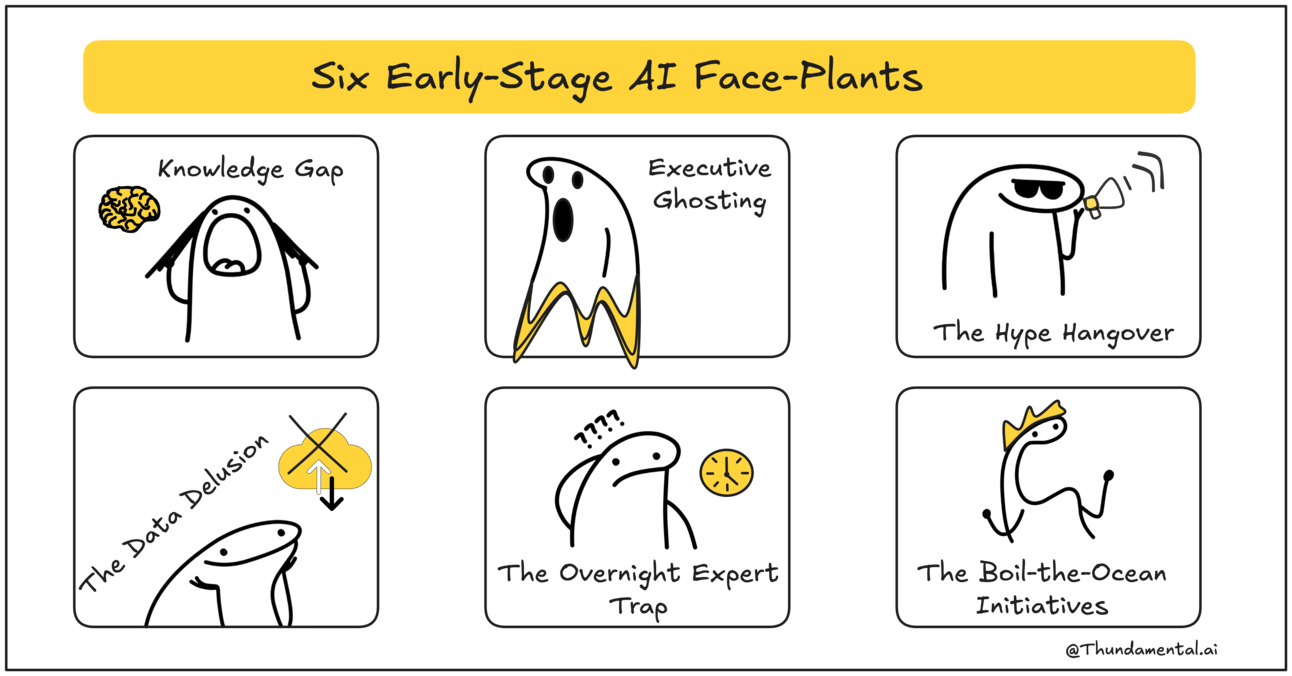
TL;DR: The quickest route to real AI value isn’t a traditional task‑force, a giant budget, or an imported guru. It’s company‑wide literacy plus a lean framework that moves from sandbox play (Crawl) to proven wins (Walk) and, only then, to scale.
Last week we looked at the flawed reactions to AI and our proposed ‘Crawl, Walk, Run, Fly” Framework.
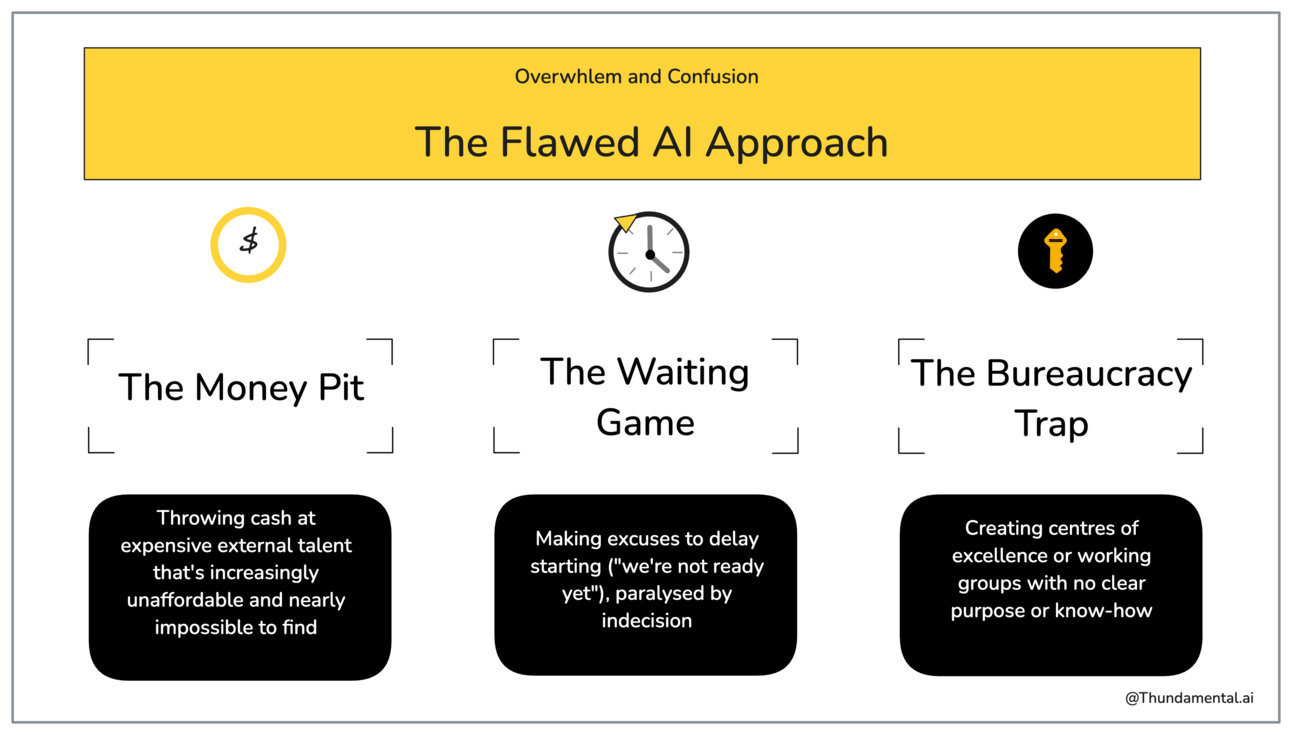
Today we will focus on when a company does take action, how an organisation can avoid failed AI starts.
When the board asks, “What’s our AI plan?” the knee-jerk response is often: “We’ve formed an AI task force.”
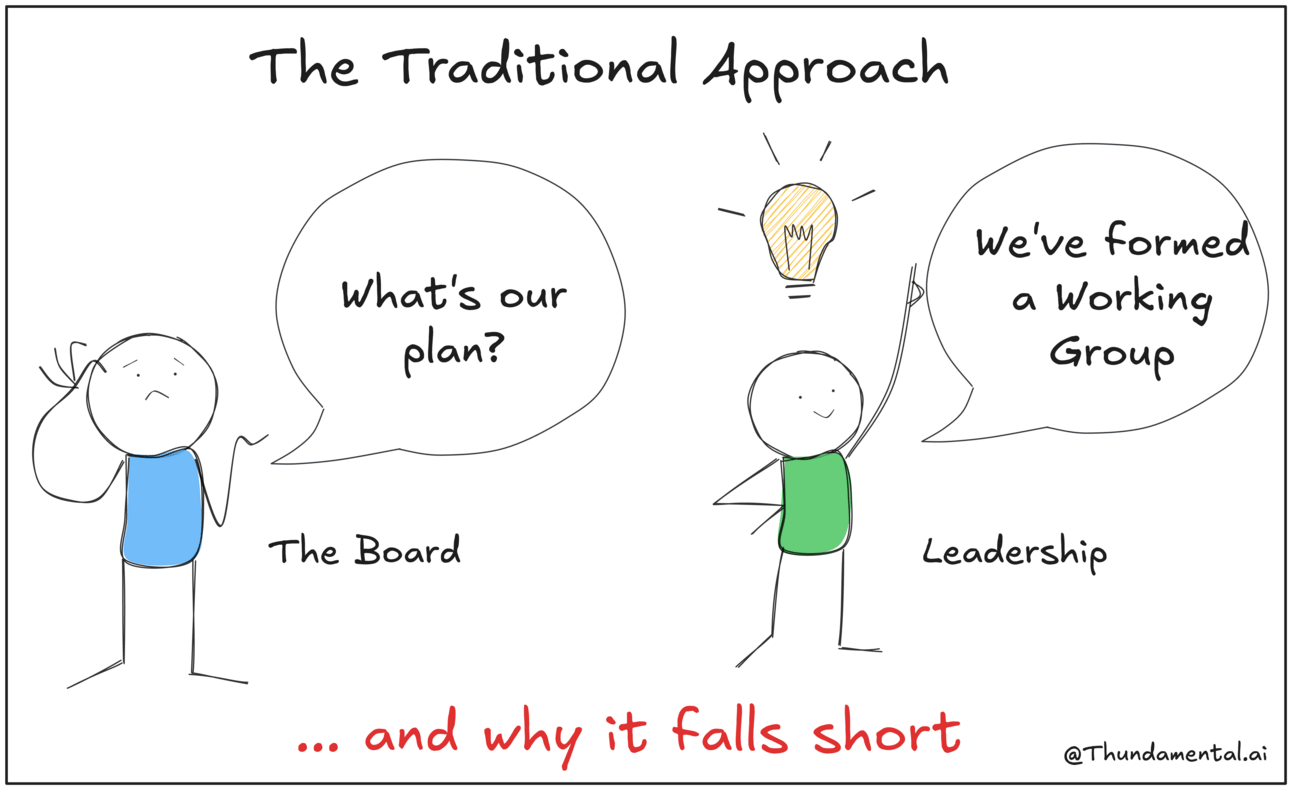
It’s a move that feels strategic, buys time, and looks good in a presentation. But too many organisations face-plant before seeing results—not because AI technology fails, but because their approach misaligns with how AI capability actually develops. Here’s a modern playbook for building sustainable AI value through company-wide literacy and a lean, incremental framework. No hype, just results.
Why Traditional Approaches Fall Short
The default corporate response to AI—forming a committee to “figure it out”—is intuitive but outdated.
Traditional working groups were built for challenges where a small team could research, deliberate, and recommend solutions. This worked when innovation moved slowly, expertise was rare, and top-down solutions sufficed.
AI, however, operates differently:
Rapid Evolution: AI advances outpace quarterly planning cycles.
Widespread Impact: Value comes from broad adoption, not centralised control.
Universal Learning Curve: AI affects everyone, not just IT.
When traditional working groups tackle AI, four common pitfalls emerge:
Island Effect: The group becomes a silo, excusing others from engaging—“The AI team will handle it.”
Knowledge Gap: Only group members gain expertise, leaving the broader organisation behind.
Implementation Misstep: Solutions built by specialists often miss real business needs.
Scaling Lag: Adoption crawls at the pace of the working group’s meeting schedule.
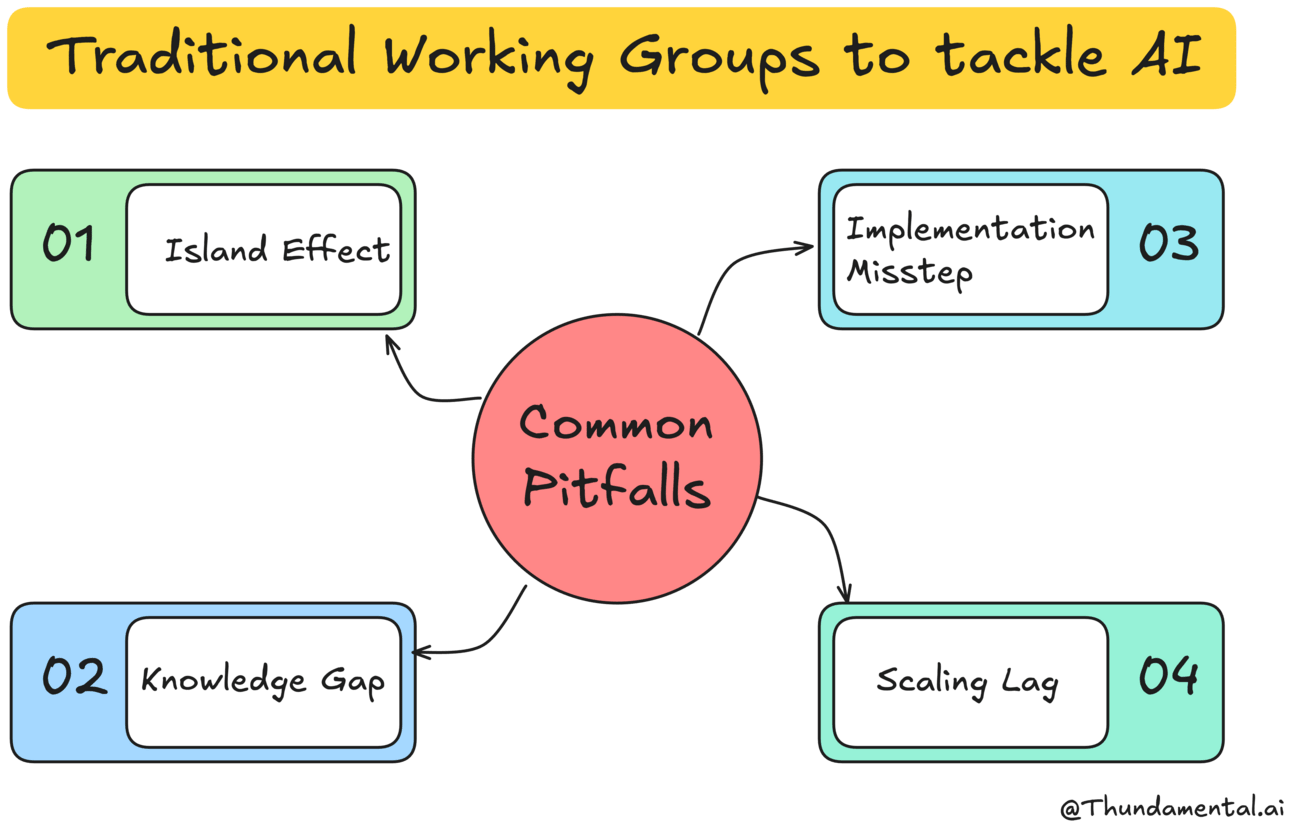
Now, let's examine the typical corporate AI journey—or as I like to call it, "Six Ways to Spend Money Without Actually Getting AI."
Six Early-Stage AI Face-Plants (And How to Avoid Them)
Many organisations waste resources on flawed AI starts.
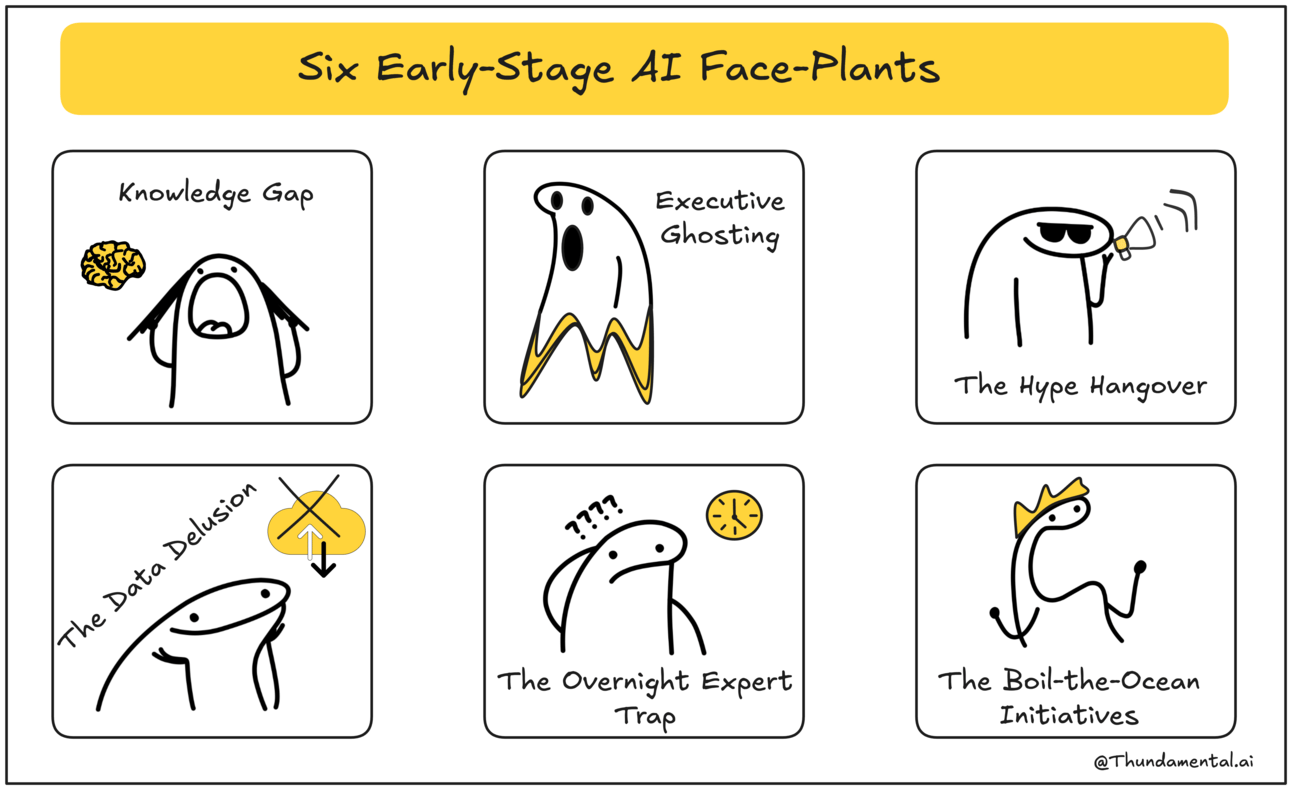
Here are six common missteps and how to sidestep them:
1. The Knowledge Vacuum
Problem: Expecting AI literacy without dedicated learning time.
What it looks like: Staff are told to "get AI‑savvy," yet every hour in their calendar is already spoken for. Without protected time to experiment, curiosity quickly turns to frustration. By month two, the #ai-learning Slack channel is a ghost town of unread links.
Without protected time to explore, even enthusiastic teams default to business as usual.
2. Executive Ghosting
Problem: Leaders champion AI in town‑halls, but vanish when budget requests appear.
What it looks like: Projects idle in PowerPoint limbo while approvals stall, signalling it was more talk than action.
Your executives ghost you… they do not approve or give a “go ahead”
3. The Hype Hangover
Problem: Executives influenced by inflated AI promises expect transformative results overnight.
What it looks like: Leadership treats AI as a magic button that will instantly fix broken processes, cut costs by 50%, and reveal groundbreaking insights—all in the first quarter. When reality doesn't match the hype cycle's promises, disillusionment sets in and budgets evaporate.
The first phase of AI adoption is about learning and small wins, not revolutionary transformation.
4. Data Delusions
Problem: Discovering unusable data too late.
What it looks like: Databases with columns named misc1 through misc9. Models learn gibberish, and faith in AI plummets faster than you can say "garbage in, garbage out."
5. The Overnight Expert Trap
Problem: One IT generalist is suddenly titled "Head of AI" while still covering their day job.
What it looks like: The employee becomes burned out, juggling roles, leading to rushed decisions
You wouldn't expect someone to become a surgeon overnight. AI expertise deserves the same respect.
6. Boil-the-Ocean Initiatives
Problem: Aiming to transform everything at once.
What it looks like: An 18‑month AI plan to overhaul three departments collapsed under complexity.
The more revolutionary your first AI project sounds, the more likely it is to fail.
A Realistic Path Forward: The Organic Approach to AI Capability
Unlike traditional technology implementations that follow a linear path, AI maturity requires a developmental approach that builds both human and technical capabilities in parallel.
AI Literacy: The Critical First Step
The single most effective way to get your foot in the AI door? Developing organisation-wide AI literacy. This doesn't require massive investment or restructuring—just a simple, organic approach:
Follow the “Crawl, Walk, Run, Fly” Framework - Start with exploration and learning before attempting ambitious implementation
Create an AI Capability Accelerator - Not a traditional working group, but a cross-functional team focused on enabling learning
Upskill Your Workforce - Build AI literacy across departments, not just in technical teams
While the full maturity framework spans four stages, the key to success lies in mastering the fundamentals first.
Many organisations mistakenly try to jump straight to RUN or FLY—setting up Centres of Excellence or enterprise-wide platforms before they've developed fundamental understanding or proven value. This leads to precisely the face-plants we've explored earlier.
Reimagining the “Working Group”
The solution isn't abandoning working groups entirely, but transforming how they function. Replace the traditional isolated committee with an AI Capability Accelerator team charged with driving learning, not delivering solutions.
While these teams could develop learning roadmaps internally, this approach takes significant time and creates knowledge gaps—especially since team members typically maintain their full-time jobs throughout this process.
Accelerating Success with External Support
A more efficient approach is bringing in short-term AI Implementation Support to guide your AI Capability Accelerator with:
Establishing the team's mandate and structure
Co-creating a comprehensive learning roadmap based on the maturity framework
Custom designing tailored workshops for each maturity stage
Identifying initial projects with the highest chance of success
Transferring knowledge so the organisation builds self-sufficiency
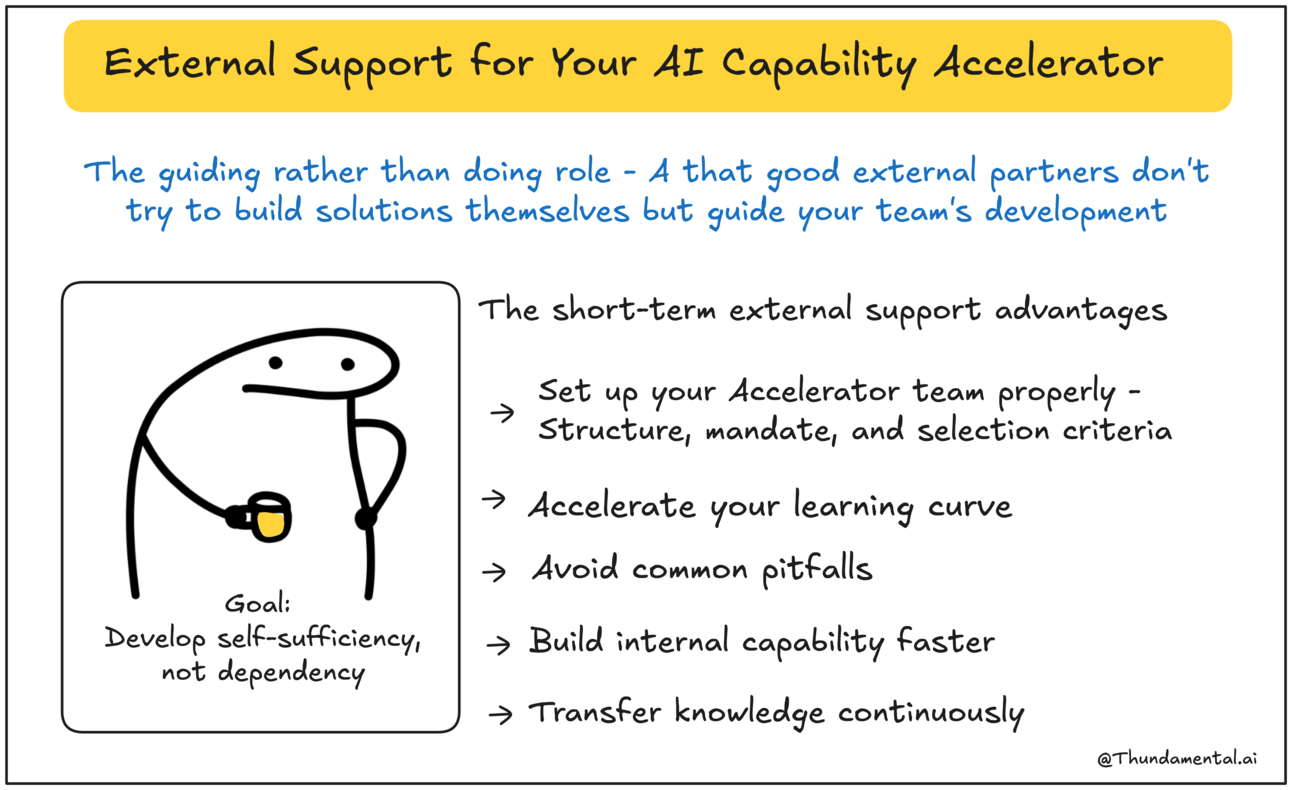
Getting Started: It’s Easier Than You Think
1. Secure (Visible) Executive Commitment
Leadership must participate visibly, use AI in their own work, protect exploration time, and celebrate learning milestones rather than demanding immediate ROI.
1. Set Up a Training and Support Budget
Allocate dedicated resources for AI education—this isn't an optional expense but a strategic investment in building critical organisational capability.
You can start small.
3. Form an AI Capability Accelerator (ex-Working Group ;)
Replace the traditional working group with a cross-functional team that facilitates rather than centralises. Select members based on curiosity and influence, not just technical backgrounds.
4. Invest in AI Literacy
The AI Capability Accelerator should leverage internal knowledge and external training to build a foundation of skills across the organization—creating a common language and baseline understanding that enables future growth.
Focus on the First Two Stages
Focus on the first two stages of the "Crawl, Walk, Run, Fly” Framework to avoid early stumbles:
Stage 1: Crawl – Explore Without Pressure
Goal: Build organisational curiosity and baseline understanding across teams.
Working group role: Coordinate learning time (5-10% of work hours), create psychological safety, and establish learning circles.
Actions:
Dedicate 2-4 hours weekly for learning (e.g., workshops on AI basics or prompt engineering).
Form cross-functional “learning circles” to share insights.
Leaders model engagement by attending sessions.
Success Metrics: 50% of staff complete an AI Fundamentals workshop and become familiar with basic AI tools and start using AI daily.
Stage 2: Walk – Prove Value
Goal: Employees solves one specific problem that could be done "better, faster, cheaper, or safer" with AI.
Working group role: Help identify appropriate first use cases, connect technical resources with business needs, and document patterns.
Actions:
Deeper AI Fluency training.
Select a low-risk, high-impact use case (e.g., automating customer query categorisation).
Pair technical staff with business units to co-design solutions.
Document results and share widely.
Success Metrics: You'll see your first genuine wins (“better, faster, cheaper, safer”) because your people have developed enough understanding to identify real opportunities.
By focusing on these fundamentals, you can avoid the common pitfalls of AI implementation and build sustainable capability that grows organically throughout your organisation.
Beyond Early Stages
After Walk, the Run stage scales proven solutions, and Fly establishes enterprise-wide AI integration, often via a Center of Excellence. These require robust governance, data standards, and regulatory compliance—topics for future discussion. For now, master the fundamentals.
Why AI Literacy Outshines Hiring Expert Employees
Hiring top AI talent is costly and slow—they’re scarce and often lack your business context. Instead, upskill your workforce. Teach basic prompt design, data wrangling, and model basics in weeks. Empowered employees build small automations, sparking organic innovation. Literacy multiplies impact: 100 trained staff outperform one elite team.
The real risk isn’t AI replacing your people—it’s being outpaced by organisations that empower their entire workforce with AI fluency.
Start small, share wins, and grow steadily.
Ready to build sustainable AI capability in your organisation?
We offers:
AI Implementation Strategy: A tailored roadmap to build organisational capability
AI Implementation Support: Set up your working group, sit in on meetings, establish its mandate, coach and accelerate your learning journey
Phase-Specific Workshops: Customised training
Don't delegate your AI future to a committee. Build organisation-wide capability with a proven approach.
👉 Schedule a free consultation and let’s get started.
If you forget everything else, remember this…
"Start Small. One step at a time. Nobody is fully ‘getting’ it, so make sure you do the groundwork.:
Don’t want to miss our next newsletter? | Or, if you’re already a subscriber… |

